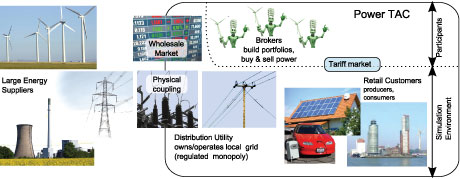by Wolfgang Ketter and John Collins
Energy is at the foundation of modern society, and almost everything about the way we produce, use, and manage energy needs to change over the next few decades. Our work is focused on understanding this transition, particularly in the electric power sector.
We have developed Power TAC, a simulation environment that models a “liberalized” retail electrical energy market that includes a significant fraction of retail-level production (eg solar, wind) and storage (eg electric vehicles) capacities [1], and allows us to experiment with market structures in a variety of potential scenarios for the future energy landscape. Figure 1 shows a schematic view of the simulation environment, which models a wholesale market, a regulated distribution utility, and a population of retail energy customers and producers, situated in a real location on Earth during a specific period for the weather data that is available.

Figure 1: Power TAC scenario overview
In this market, competing business entities or “brokers” offer energy services to customers through tariff contracts, and must then serve those customers by trading in the wholesale market. Brokers are challenged to maximize their profits by buying and selling energy in the wholesale and retail markets, subject to fixed costs and constraints. Costs include fees for publication and withdrawal of tariffs, and distribution fees for transporting energy to their contracted customers. Costs are also incurred whenever there is an imbalance between a broker’s total contracted energy supply and demand within a given time slot. The competition revolves around brokers who play against each other to maximize their profits.
The distribution utility models the regulated natural monopoly that owns the regional distribution network, and is responsible for maintenance of its infrastructure and for real-time balancing of supply and demand. The balancing process is a market-based mechanism that uses economic incentives to encourage brokers to achieve balance within their portfolios of tariff subscribers and wholesale market positions, in the face of stochastic customer behaviours and weather-dependent renewable energy sources. The broker with the highest profit at the end of the simulation wins.
The Power TAC wholesale market is a relatively simple call market, similar to many existing wholesale electric power markets, such as Nord Pool in Scandinavia or FERC markets in North America, but unlike the FERC markets we model a single region, and therefore we do not model locational-marginal pricing.
Broker developers face a number of interesting challenges. Broker agents operate in a fast-paced information-rich environment. Customer behaviour is stochastic, and depends partially on weather and the actions of brokers. Brokers are challenged to predict customer power usage and wholesale market prices up to 24 hours in advance, and have multiple available actions to interact with the markets and influence customer behaviour. The competitive environment is oligopolistic, which means that broker actions have observable impacts on the competitive environment, and so accurate predictions may need to account for the effects of a broker’s own actions in order to model the effects of other brokers’ actions. Successful broker agent designs will typically integrate a variety of techniques from artificial intelligence, machine learning, and game theory [2].
There are many important open questions and research challenges posed by a power grid with large numbers of active participants. Examples include the role of retail brokers and their customers in grid balancing; demand-side management using dynamic pricing; forecasting supply, demand, and prices in the future grid; tariff terms and customer preferences; and impact of electric vehicle penetration on the grid. A number of these questions concern the structure of markets and the behaviours of market participants. Some of these can be addressed by game-theoretic analysis, but many are sufficiently complex that they cannot be effectively addressed by formal methods. To address these more complex issues, simulation-based techniques are required. Unlike more traditional simulation methods, Power TAC is a competitive simulation [2] that invites research teams to write their own autonomous software agents that compete with each other in rich economic simulation environments through annual competitions. Competitions produce large quantities of data, as well as the competing agent software, which will be publically available for analysis by any interested parties. The ongoing discussion of Smart Markets [3] recommends rich market simulations such as Power TAC to validate market structures and to minimize real-world risks.
The 2013 competition is scheduled in conjunction with Association for the Advanced of Artificial Intelligence (AAAI) conference for July 2013 in Bellevue, WA, USA. Interested individuals and groups are invited to participate.
Link: http://www.powertac.org
References:
[1] W. Ketter, et al: “The 2012 Power Trading Agent Competition”, Tech. Rep. ERS-2012-010-LIS, RSM Erasmus University, Rotterdam, The Netherlands (2012) http://ssrn.com/paper=2144644
[2] W. Ketter, A. Symeonidis: “Competitive benchmarking: Lessons learned from the Trading Agent Competition”; AI Magazine 33 (1), 2012
[3] M. Bichler, A. Gupta, A., W. Ketter: “Designing smart markets”; Information Systems Research 21 (4), 688–699, 2010.
Please contact:
Wolfgang Ketter
Erasmus University, The Netherlands
Tel: +31104082624
E-mail:
http://www.rsm.nl/energy











